
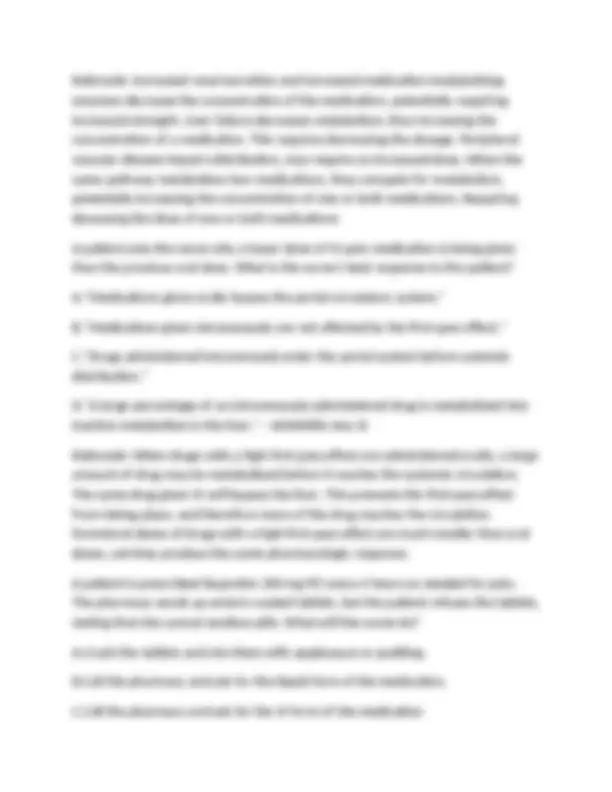
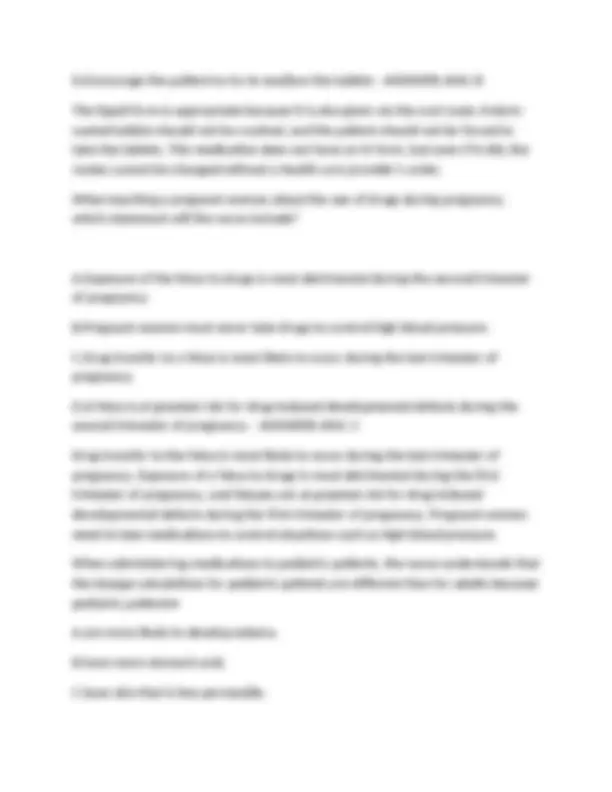
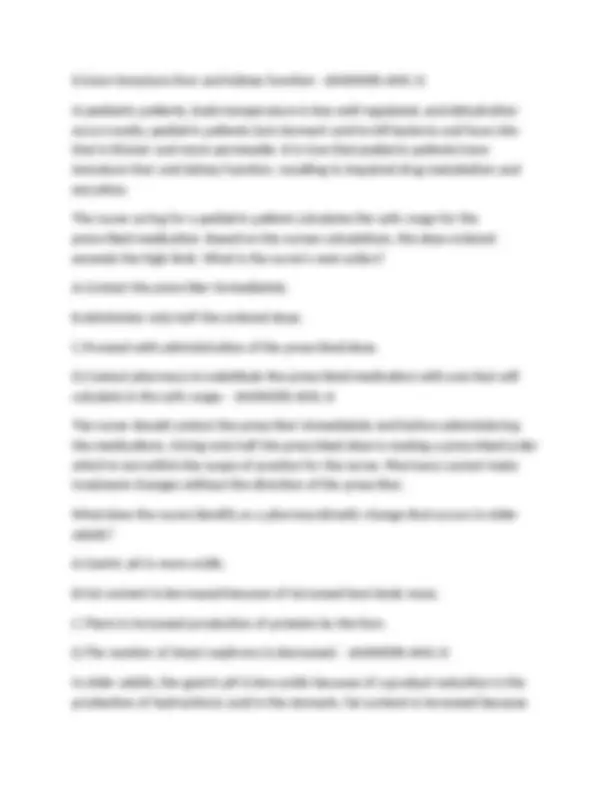
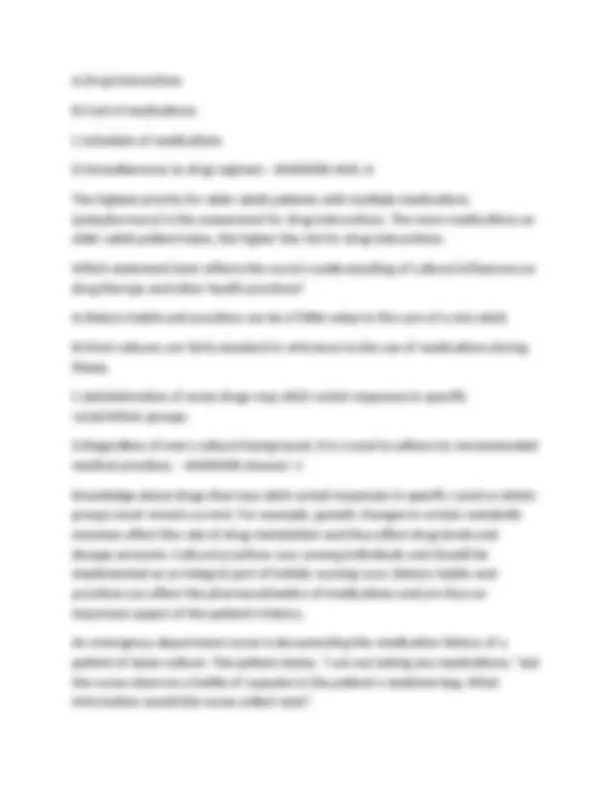
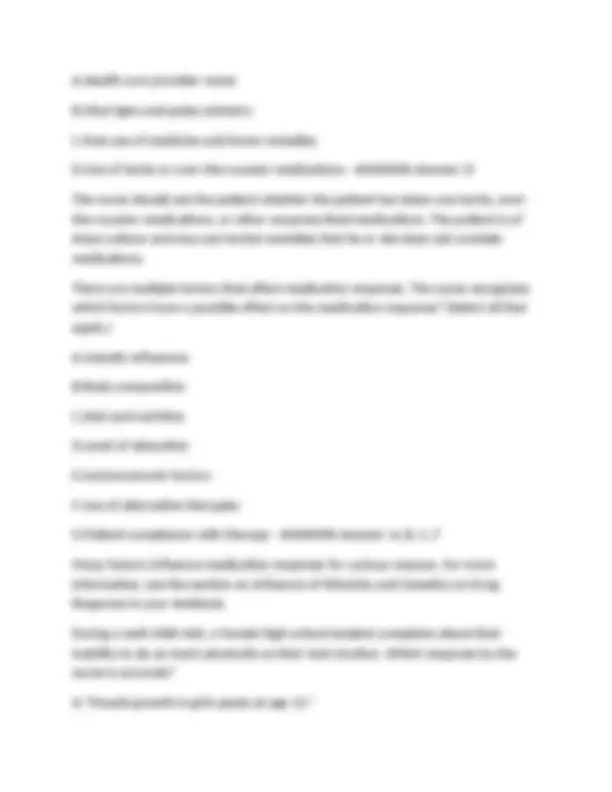
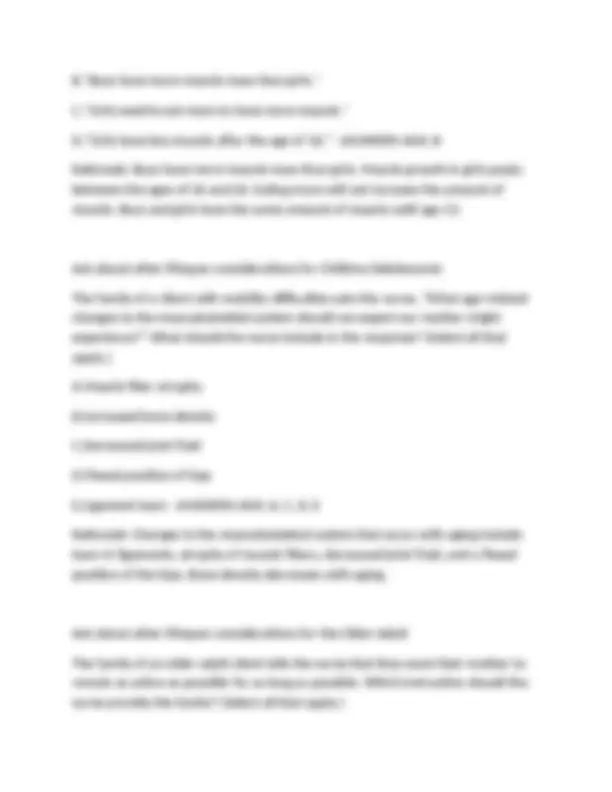
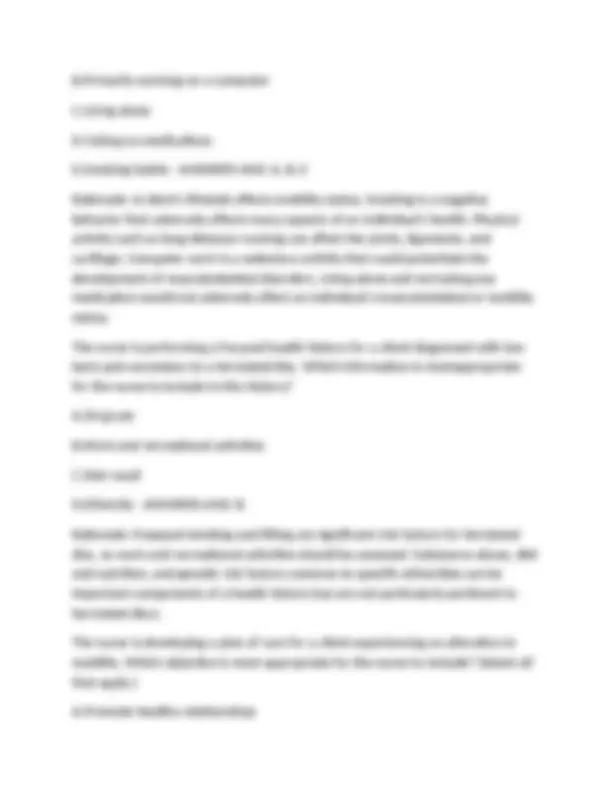
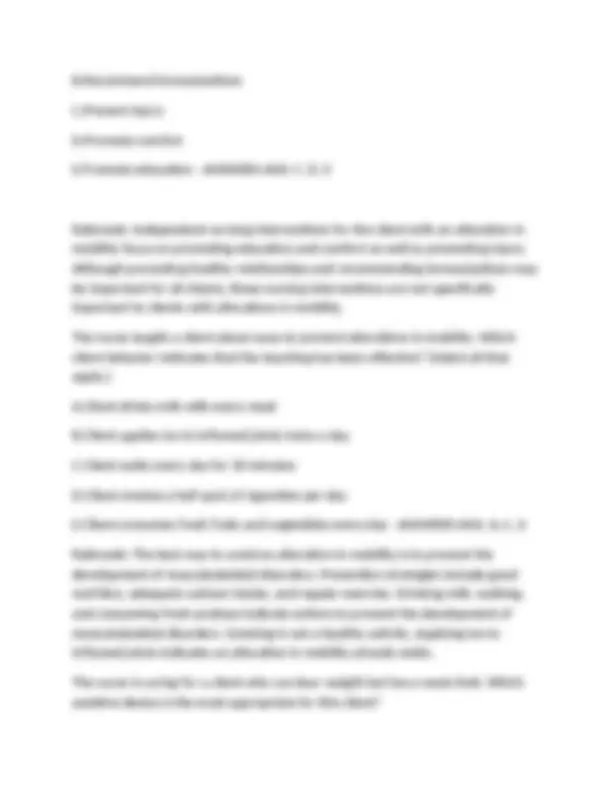
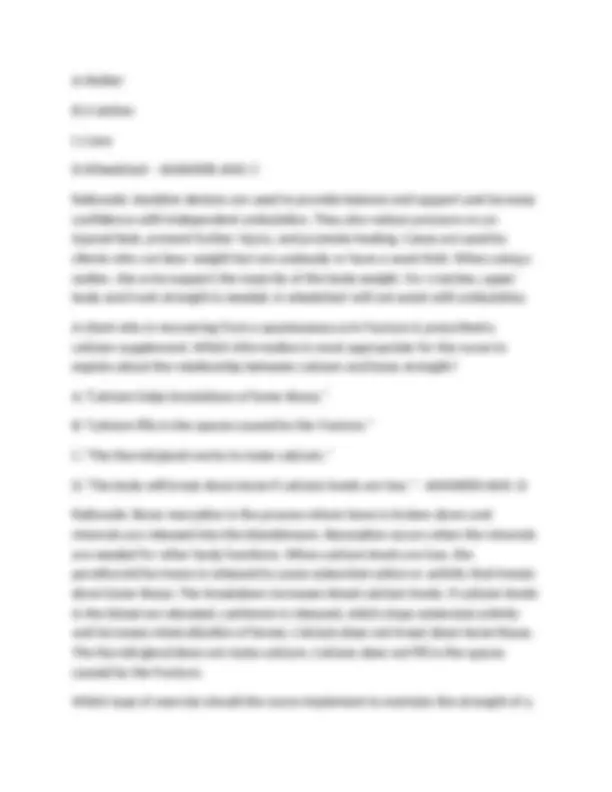
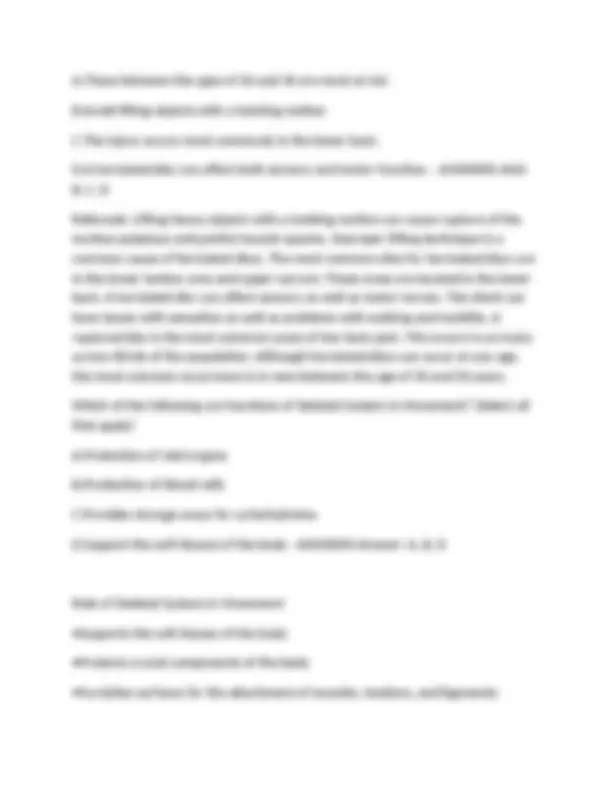
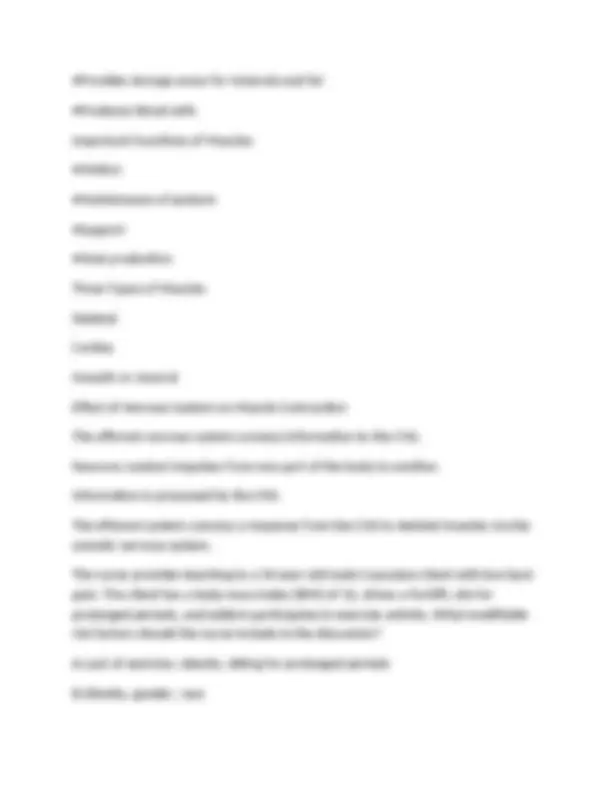
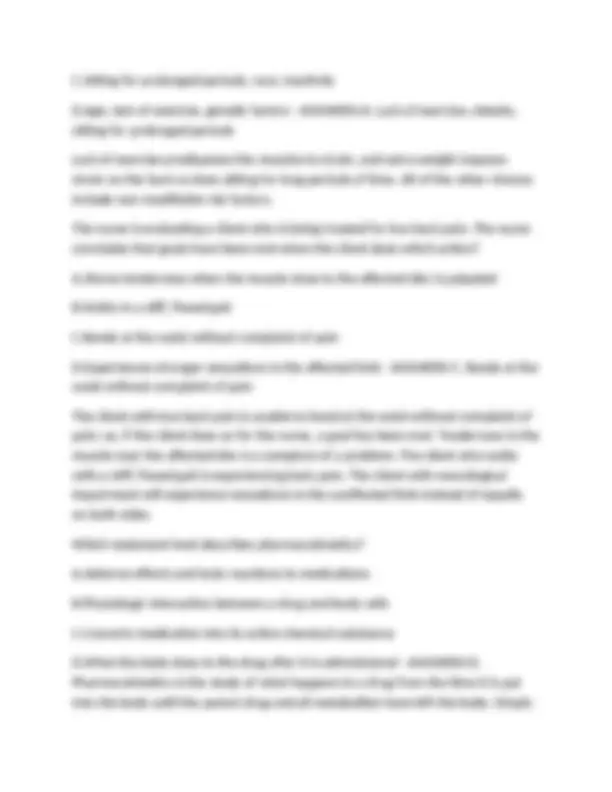
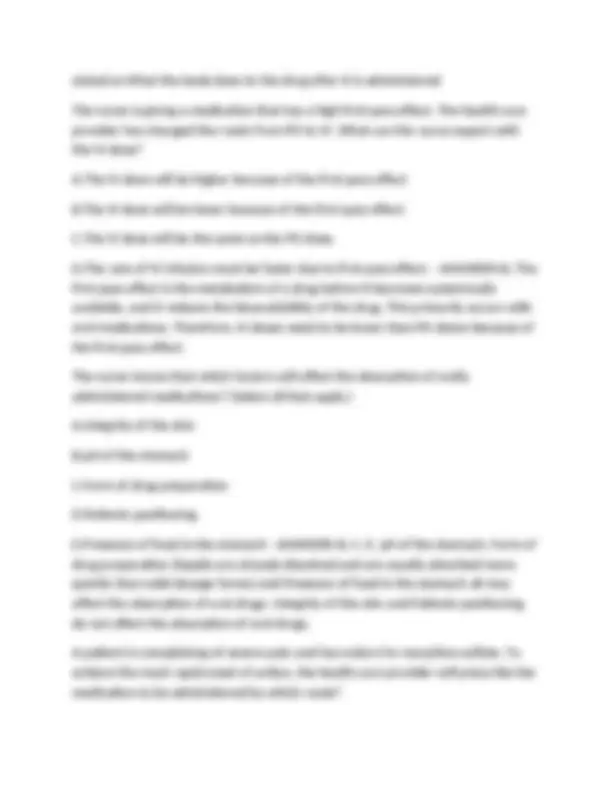
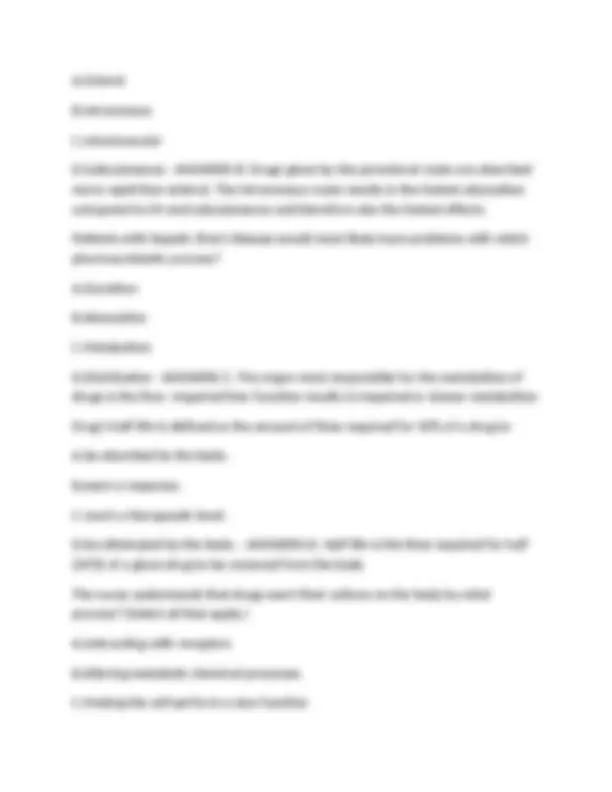
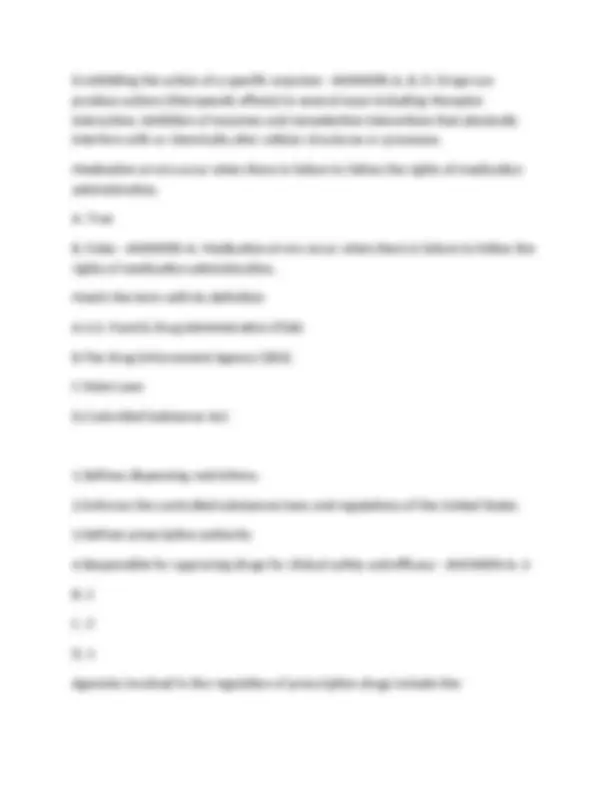
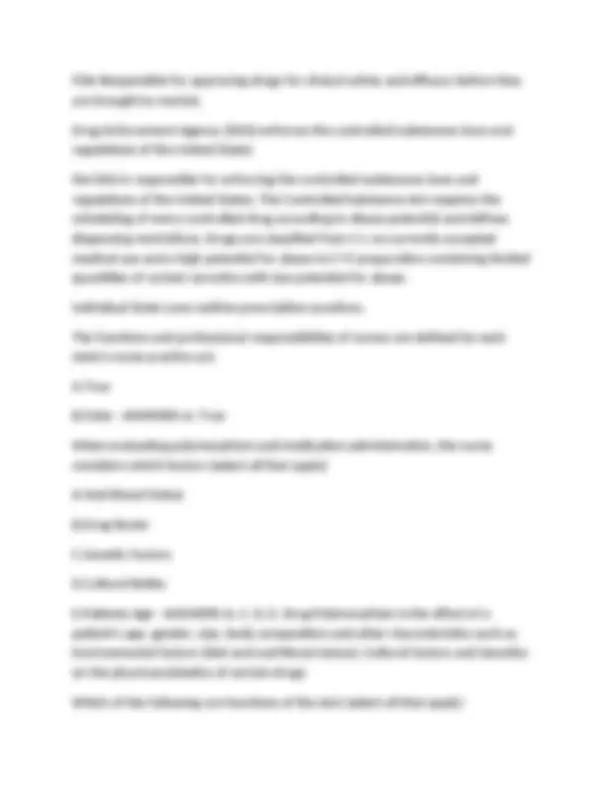
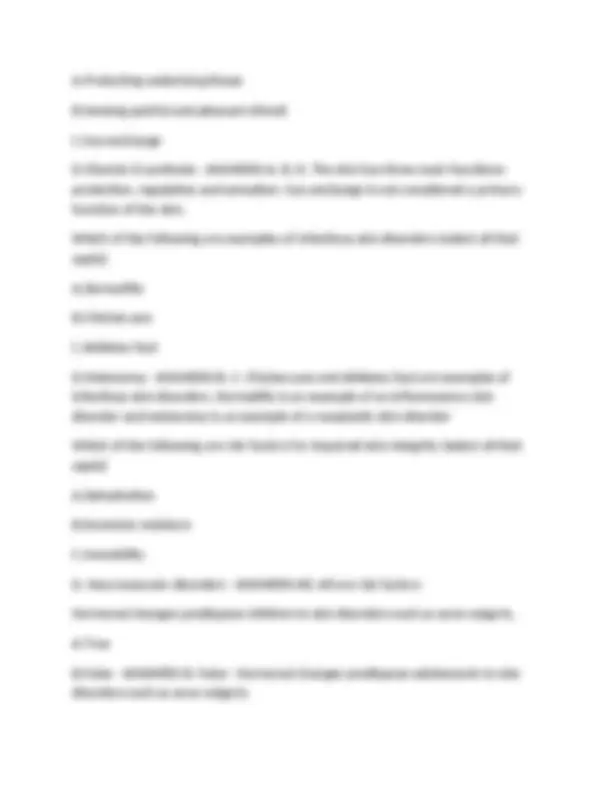
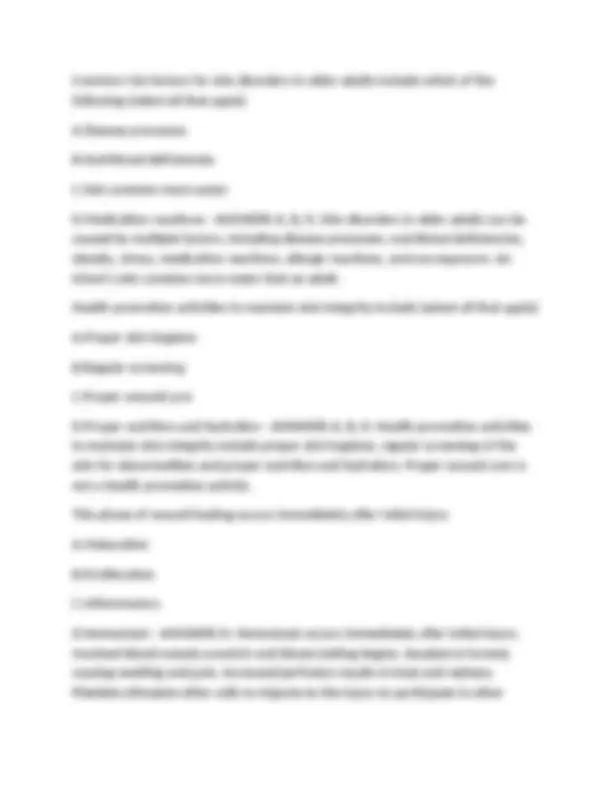
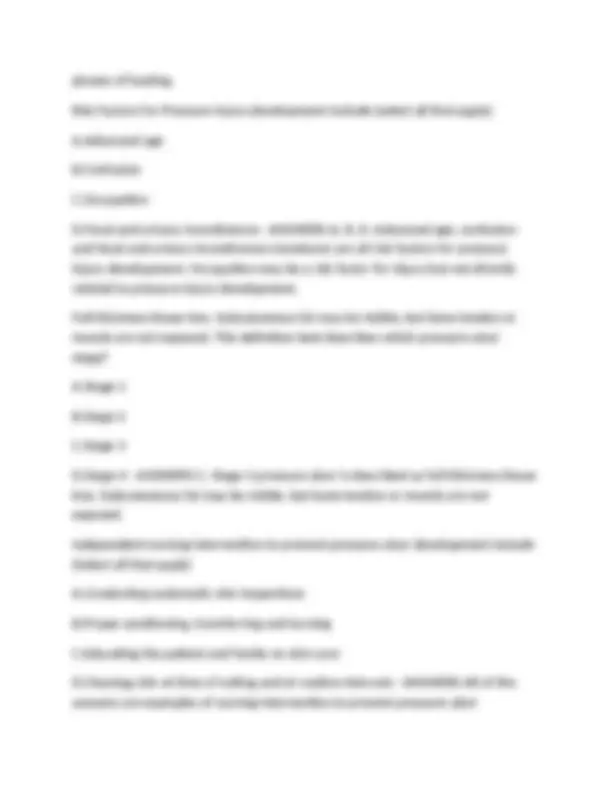
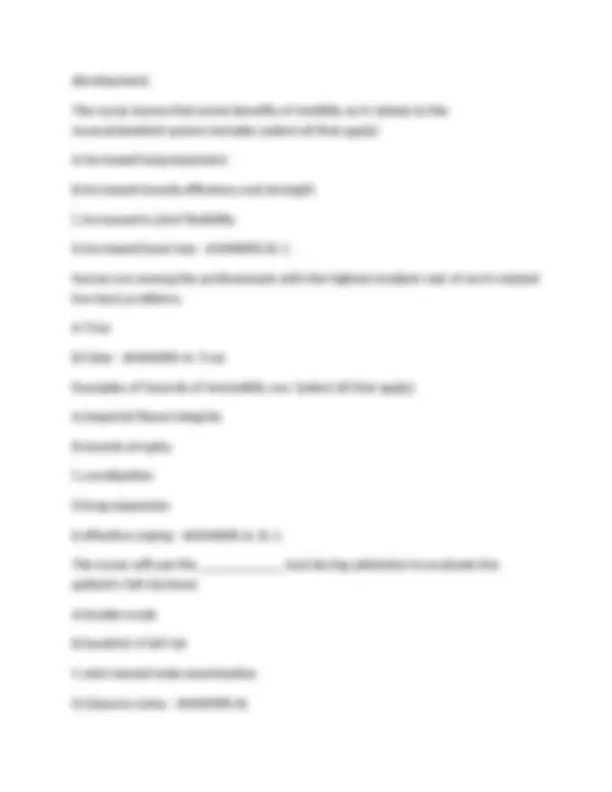
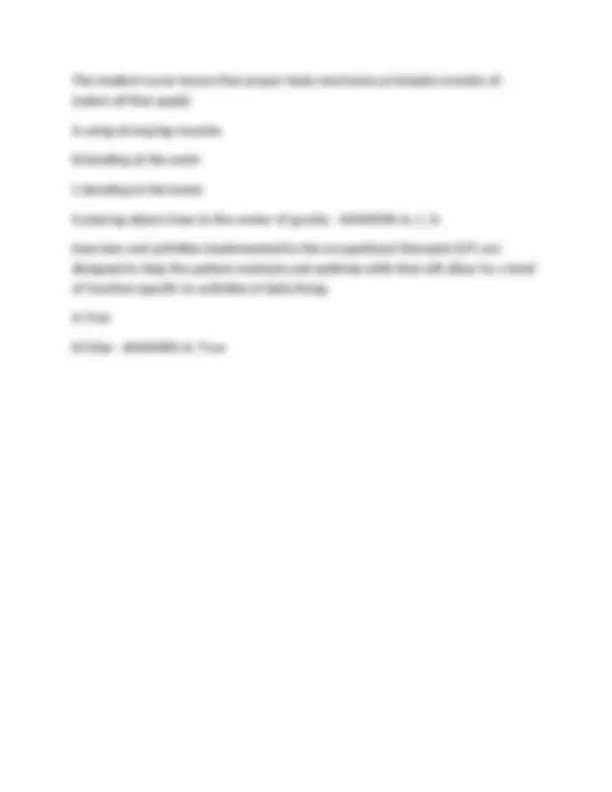


Study with the several resources on Docsity

Earn points by helping other students or get them with a premium plan


Prepare for your exams
Study with the several resources on Docsity

Earn points to download
Earn points by helping other students or get them with a premium plan
Community
Ask the community for help and clear up your study doubts
Discover the best universities in your country according to Docsity users
Free resources
Download our free guides on studying techniques, anxiety management strategies, and thesis advice from Docsity tutors
NURSE 100 EXAM 3 QUESTIONS WITH COMPLETE SOLUTIONS 2025 LATEST UPDATE GRADED A+ NURSE 100 EXAM 3 QUESTIONS WITH COMPLETE SOLUTIONS 2025 LATEST UPDATE GRADED A+
Typology: Exams
1 / 29

This page cannot be seen from the preview
Don't miss anything!






















What is the study of physiochemical properties of drugs and how they influence the body called? A.Pharmaceutics B.Pharmacokinetics C.Pharmacodynamics D.Pharmacotherapeutics - ANSWERS-ANS: C Pharmacodynamics: The study of what the drug does to the body. The study of the biochemical and physiologic interactions of drugs at their sites of activity. It examines the effect of the drug on the body. (Lilley, 2020 p. 14) Pharmacokinetics: The study of what the body does to the drug. The study of what happens to a drug from the time it is put into the body until the parent drug and all metabolites have left the body. Pharmacokinetics represent the drug absorption into, distribution and metabolism within, and excretion from the body. (Lilley, 2020 p. 14) Pharmacotherapeutics: The treatment of pathologic conditions through the use of drugs. (Lilley, 2020 p. 14) Pharmaceutics The science of preparing and dispensing drugs, including dosage form design. (Lilley, 2020 p. 14) The study of how various drug forms influence the way in which the drug affects the body. (Lilley, 2020 p. 16 A patient asks the nurse the difference between a generic drug and a trade or brand-name drug. Which of the following are true regarding generic drugs? (Select all that apply) A.Have less potential for abuse and dependence B.Have the same chemical composition as the brand-name drug
C.May have several brand names D.May have several generic names E.Are usually less expensive than a brand-name drug - ANSWERS-Answer: B, C, E Generic and trade or brand-name drugs have the same chemical composition and the same effects, Generic drugs are usually less expensive. Each drug has only one generic name. The trade name is the brand of proprietary name given by the manufacturer; various manufacturers give the drug different brand names. There is no difference in abuse potential between a generic and brand-name drug. Patients with renal failure would most likely have problems with which pharmacokinetic process? A.Excretion B.Absorption C.Metabolism D.Distribution - ANSWERS-ANS: A The kidneys are responsible for the majority of drug excretion. A patient with renal failure would have a difficult time with drug excretion. A staff educator is preparing an in-service to review factors that influence medication metabolism. Which of the following would the educator include as a reason to administer a lower medication dosage? (Select all that apply) A.Increased renal excretion B.Increased medication-metabolizing enzymes C.Liver failure D.Peripheral vascular disease E.Concurrent use of medication with the same pathway of metabolism - ANSWERS-Answer: C, E
D.Encourage the patient to try to swallow the tablets - ANSWERS-ANS: B The liquid form is appropriate because it is also given via the oral route. Enteric- coated tablets should not be crushed, and the patient should not be forced to take the tablets. This medication does not have an IV form, but even if it did, the routes cannot be changed without a health care provider's order. When teaching a pregnant woman about the use of drugs during pregnancy, which statement will the nurse include? A.Exposure of the fetus to drugs is most detrimental during the second trimester of pregnancy. B.Pregnant women must never take drugs to control high blood pressure. C.Drug transfer to a fetus is most likely to occur during the last trimester of pregnancy. D.A fetus is at greatest risk for drug-induced developmental defects during the second trimester of pregnancy. - ANSWERS-ANS: C Drug transfer to the fetus is most likely to occur during the last trimester of pregnancy. Exposure of a fetus to drugs is most detrimental during the first trimester of pregnancy, and fetuses are at greatest risk for drug-induced developmental defects during the first trimester of pregnancy. Pregnant women need to take medications to control situations such as high blood pressure. When administering medications to pediatric patients, the nurse understands that the dosage calculations for pediatric patients are different than for adults because pediatric patients• A.are more likely to develop edema. B.have more stomach acid. C.have skin that is less permeable.
D.have immature liver and kidney function - ANSWERS-ANS: D In pediatric patients, body temperature is less well regulated, and dehydration occurs easily; pediatric patients lack stomach acid to kill bacteria and have skin that is thinner and more permeable. It is true that pediatric patients have immature liver and kidney function, resulting in impaired drug metabolism and excretion. The nurse caring for a pediatric patient calculates the safe range for the prescribed medication. Based on the nurses calculations, the dose ordered exceeds the high limit. What is the nurse's next action? A.Contact the prescriber immediately. B.Administer only half the ordered dose. C.Proceed with administration of the prescribed dose. D.Contact pharmacy to substitute the prescribed medication with one that will calculate in the safe range. - ANSWERS-ANS: A The nurse should contact the prescriber immediately and before administering the medications. Giving only half the prescribed dose is making a prescribed order which is not within the scope of practice for the nurse. Pharmacy cannot make treatment changes without the direction of the prescriber. What does the nurse identify as a pharmacokinetic change that occurs in older adults? A.Gastric pH is more acidic. B.Fat content is decreased because of increased lean body mass. C.There is increased production of proteins by the liver. D.The number of intact nephrons is decreased. - ANSWERS-ANS: D In older adults, the gastric pH is less acidic because of a gradual reduction in the production of hydrochloric acid in the stomach, fat content is increased because
B.Increase the amount of drug given. C.Shorten the time interval between doses. D.Administer the medication intravenously. - ANSWERS-ANS: A A lower binding capacity leaves more drugs available for action; thus, a lower dose would be required to prevent toxicity. ASK- What other populations may be at risk of decreased albumin? Malnourished, older adults The physiologic changes that normally occur in older adult patients have which implication for drug response? A.Drug elimination is faster. B.Drug metabolism is quicker. C.Drug half-life is lengthened. D.Protein binding is more efficient. - ANSWERS-ANS: C Drug half-life is extended secondary to diminished liver and renal function in older adults. Review: Older patients may be at risk for drug toxicity due to delayed drug metabolism related to reduced hepatic blood flow and decreased liver enzyme production. Other physiological changes in older adult are decreased blood flow to the kidneys and reduced glomerular filtration rate, increased body fat, decreased cardiac output, decreased gastric emptying and slowed peristalsis. A nurse working with older adult patients is concerned about the number of medications prescribed for each patient. Which older adult assessment should be of highest priority related to polypharmacy?
A.Drug interactions B.Cost of medications C.Schedule of medications D.Nonadherence to drug regimen - ANSWERS-ANS: A The highest priority for older adult patients with multiple medications (polypharmacy) is the assessment for drug interactions. The more medications an older adult patient takes, the higher the risk for drug interactions. Which statement best reflects the nurse's understanding of cultural influences on drug therapy and other health practices? A.Dietary habits and practices can be of little value to the care of a sick adult. B.Most cultures are fairly standard in reference to the use of medications during illness. C.Administration of some drugs may elicit varied responses in specific racial/ethnic groups. D.Regardless of one's cultural background, it is crucial to adhere to recommended medical practices. - ANSWERS-Answer: C Knowledge about drugs that may elicit varied responses in specific racial or ethnic groups must remain current. For example, genetic changes in certain metabolic enzymes affect the rate of drug metabolism and thus affect drug levels and dosage amounts. Cultural practices vary among individuals and should be implemented as an integral part of holistic nursing care. Dietary habits and practices can affect the pharmacokinetics of medications and are thus an important aspect of the patient's history. An emergency department nurse is documenting the medication history of a patient of Asian culture. The patient states, "I am not taking any medications," but the nurse observes a bottle of capsules in the patient's medicine bag. What information would the nurse collect next?
B."Boys have more muscle mass than girls." C."Girls need to eat more to have more muscle." D."Girls have less muscle after the age of 16." - ANSWERS-ANS: B Rationale: Boys have more muscle mass than girls. Muscle growth in girls peaks between the ages of 16 and 20. Eating more will not increase the amount of muscle. Boys and girls have the same amount of muscle until age 13. Ask about other lifespan considerations for Children/Adolescents The family of a client with mobility difficulties asks the nurse, "What age-related changes to the musculoskeletal system should we expect our mother might experience?" What should the nurse include in the response? (Select all that apply.) A.Muscle fiber atrophy B.Increased bone density C.Decreased joint fluid D.Flexed position of hips E.Ligament tears - ANSWERS-ANS: A, C, D, E Rationale: Changes in the musculoskeletal system that occur with aging include tears in ligaments, atrophy of muscle fibers, decreased joint fluid, and a flexed position of the hips. Bone density decreases with aging. Ask about other lifespan considerations for the Older Adult The family of an older adult client tells the nurse that they want their mother to remain as active as possible for as long as possible. Which instruction should the nurse provide the family? (Select all that apply.)
A.Adequate calcium intake B.Good nutritional intake C.Daily stretching D.Regular exercise E.Adequate rest and sleep - ANSWERS-ANS: All are correct Primary Prevention includes maintaining the highest level of regular physical activity possible along with optimal nutrition, keeping an ideal body weight, and getting adequate rest. Taking measures to prevent injury and trauma are also considered primary prevention strategies. Nutrition, as a primary prevention strategy, links to musculoskeletal development. During infancy, childhood, and adolescence, adequate protein and calcium in the diet are critical for the musculoskeletal development. Adequate calcium intake is also necessary to prevent osteoporosis among older individuals. Fall prevention is an important aspect of primary prevention. Strategies include participating in regular physical activity (to maintain muscle strength, flexibility and balance), making the environment safer (e.g., avoiding hazards, using handrails, wearing sturdy shoes with nonslip soles, and having adequate lighting), and optimizing vision.8 (Giddens) Recommendations for keeping one's back healthy (NIH: National Institute of Neurological Disorders and Stroke) •Always stretch before exercise or other strenuous physical activity. •Don't slouch when standing or sitting. •At home or work, make sure work surfaces are at a comfortable height. •Sit in a chair with good lumbar support and proper position and height for the task.
B.Primarily working on a computer C.Living alone D.Taking no medications E.Smoking habits - ANSWERS-ANS: A, B, E Rationale: A client's lifestyle affects mobility status. Smoking is a negative behavior that adversely affects many aspects of an individual's health. Physical activity such as long-distance running can affect the joints, ligaments, and cartilage. Computer work is a sedentary activity that could potentiate the development of musculoskeletal disorders. Living alone and not taking any medication would not adversely affect an individual's musculoskeletal or mobility status. The nurse is performing a focused health history for a client diagnosed with low back pain secondary to a herniated disc. Which information is mostappropriate for the nurse to include in this history? A.Drug use B.Work and recreational activities C.Diet recall D.Ethnicity - ANSWERS-ANS: B Rationale: Frequent twisting and lifting are significant risk factors for herniated disc, so work and recreational activities should be assessed. Substance abuse, diet and nutrition, and genetic risk factors common to specific ethnicities can be important components of a health history but are not particularly pertinent to herniated discs. The nurse is developing a plan of care for a client experiencing an alteration in mobility. Which objective is most appropriate for the nurse to include? (Select all that apply.) A.Promote healthy relationships
B.Recommend immunizations C.Prevent injury D.Promote comfort E.Promote education - ANSWERS-ANS: C, D, E Rationale: Independent nursing interventions for the client with an alteration in mobility focus on promoting education and comfort as well as preventing injury. Although promoting healthy relationships and recommending immunizations may be important for all clients, these nursing interventions are not specifically important to clients with alterations in mobility. The nurse taught a client about ways to prevent alterations in mobility. Which client behavior indicates that the teaching has been effective? (Select all that apply.) A.Client drinks milk with every meal B.Client applies ice to inflamed joints twice a day C.Client walks every day for 30 minutes D.Client smokes a half pack of cigarettes per day E.Client consumes fresh fruits and vegetables every day - ANSWERS-ANS: A, C, E Rationale: The best way to avoid an alteration in mobility is to prevent the development of musculoskeletal disorders. Prevention strategies include good nutrition, adequate calcium intake, and regular exercise. Drinking milk, walking, and consuming fresh produce indicate actions to prevent the development of musculoskeletal disorders. Smoking is not a healthy activity. Applying ice to inflamed joints indicates an alteration in mobility already exists. The nurse is caring for a client who can bear weight but has a weak limb. Which assistive device is the most appropriate for this client?
limb with an immobilized joint? A.Passive exercise B.Isometric exercise C.Resistive exercise D.Range of motion exercise - ANSWERS-ANS: B Rationale: Isometric exercise is used to maintain strength when a joint is immobilized. It is performed by contracting a specific muscle group against another muscle group or immovable object. Resistive exercise is active exercise where the client works against resistance to increase muscle strength. Range-of- motion exercises help maintain joint mobility during periods of restricted activity. Passive exercises are performed by a physical therapist or nurse for the client. The nurse begins an early ambulation routine with a client diagnosed with altered mobility. Which benefit of early ambulation should the nurse explain to the client? (Select all that apply.) A.Promotes diarrhea B.Strengthens muscles C.Improves skin turgor D.Improves self-esteem E.Reduces risk of thrombophlebitis - ANSWERS-ANS: B, D, E Rationale: Early ambulation decreases the risk of complications of inactivity, including thrombophlebitis, osteoporosis, muscle atrophy, constipation, and urinary incontinence. It also strengthens muscles, increases joint flexibility, stimulates circulation, and improves self-esteem. Ambulation does not promote diarrhea or improve skin turgor. Which nonpharmacologic option for back pain relief would be most appropriate for the nurse to discuss with a client? (Select all that apply.)
A.Hydrotherapy B.Massage therapy C.Bedrest D.Weight lifting E.Acupuncture - ANSWERS-ANS: A, B, E Rationale: Clients with pain may want to seek out nonpharmacologic methods of pain relief. The nurse may discuss acupuncture, massage therapy, hydrotherapy, and other methods of pain relief. Bedrest and weight lifting would be contraindicated. A client presents with mild back pain. Which topics should the nurse include in teaching the client to prevent back injury? (Select all that apply.) A.Regular exercise B.Good posture C.Beginning exercise such as running D.Maintaining a healthy weight E.Using proper body mechanics - ANSWERS-ANS: A, B, D, E Rationale: Prevention of a herniated disc is focused on good back care. This includes good posture when sitting and standing; regular exercise, including weight-bearing exercises such as yoga and tai chi to keep back muscles strong; maintaining a healthy weight to keep pressure off the vertebral column; and using proper body mechanics. Running is a very jarring exercise and not recommended to prevent a herniated disc. The nurse is preparing educational materials concerning back injuries and herniated discs for a health fair at a local community center. Which information should the nurse include in the educational materials? (Select all that apply.)
•Provides storage areas for minerals and fat •Produces blood cells Important Functions of Muscles •Motion •Maintenance of posture •Support •Heat production Three Types of Muscles Skeletal Cardiac Smooth or visceral Effect of Nervous System on Muscle Contraction The afferent nervous system conveys information to the CNS. Neurons conduct impulses from one part of the body to another. Information is processed by the CNS. The efferent system conveys a response from the CNS to skeletal muscles via the somatic nervous system. The nurse provides teaching to a 50-year-old male Caucasian client with low back pain. The client has a body mass index (BMI) of 32, drives a forklift, sits for prolonged periods, and seldom participates in exercise activity. What modifiable risk factors should the nurse include in the discussion? A.Lack of exercise, obesity, sitting for prolonged periods B.Obesity, gender, race
C.Sitting for prolonged periods, race, inactivity D.Age, lack of exercise, genetic factors - ANSWERS-A: Lack of exercise, obesity, sitting for prolonged periods Lack of exercise predisposes the muscles to strain, and extra weight imposes strain on the back as does sitting for long periods of time. All of the other choices include non-modifiable risk factors. The nurse is evaluating a client who is being treated for low back pain. The nurse concludes that goals have been met when the client does which action? A.Shows tenderness when the muscle close to the affected disc is palpated B.Walks in a stiff, flexed gait C.Bends at the waist without complaint of pain D.Experiences stronger sensations in the affected limb - ANSWERS-C. Bends at the waist without complaint of pain The client with low back pain is unable to bend at the waist without complaint of pain; so, if the client does so for the nurse, a goal has been met. Tenderness in the muscle near the affected disc is a symptom of a problem. The client who walks with a stiff, flexed gait is experiencing back pain. The client with neurological impairment will experience sensations in the unaffected limb instead of equally on both sides. Which statement best describes pharmacokinetics? A.Adverse effects and toxic reactions to medications B.Physiologic interaction between a drug and body cells C.Converts medication into its active chemical substance D.What the body does to the drug after it is administered - ANSWERS-D. Pharmacokinetics is the study of what happens to a drug from the time it is put into the body until the parent drug and all metabolites have left the body. Simply